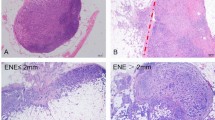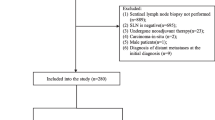Abstract
The skip metastasis (SM) of axillary lymph nodes (ALN) in breast cancer is an important phenomenon which is crucial to determine the correct choice of surgical resection. The mechanism of SM of ALN is unclear. Gli1 protein is a core epithelial-to-mesenchymal transition (EMT) regulatory factor that plays essential roles in both development and disease processes and has been associated with metastasis in carcinomas. The aim of this study was to investigate the clinicopathological characteristics of SM and evaluate the significance of Gli1 expression in breast cancer patients with metastasis of ALN. Clinicopathological data from 1,037 female breast cancer patients who underwent radical mastectomy were retrospectively reviewed. In this study, an SM was defined as level I absence but level II and/or level III involvement. The expression of Gli1 was evaluated by immunohistochemistry in 102 non-SM cases with positive nodes and 33 SM cases. In univariate analysis, we found that pN category, TNM stage, intrinsic subtypes and Gli1 expression was significant risk factor of SM. Further logistic regression analysis revealed that luminal A cases had a lower risk of SM relative to luminal B 1 (HER2 negative) cases. Further multivariate analysis revealed that Gli1 expression and numbers of positive lymph nodes were the independent factors which associated with SM. Collectively, Breast cancer with SM of ALN associated with the intrinsic subtype of the luminal B1. Gli1 expression related with the procession of breast cancer with SM, which can be used as a predictor of SM of ALN in breast cancer.

Similar content being viewed by others
References
Chevinsky AH, Ferrara J, James AG, Minton JP, Young D, Farrar WB. Prospective evaluation of clinical and pathologic detection of axillary metastases in patients with carcinoma of the breast. Surgery. 1990;108(4):612–7. discussion 617–618.
Msuya CA, Hartveit F. Skip lesions in the axilla in breast cancer, and their association with micrometastases. Breast Cancer Res Treat. 1991;19(3):277–81.
Senofsky GM, Moffat Jr FL, Davis K, Masri MM, Clark KC, Robinson DS, et al. Total axillary lymphadenectomy in the management of breast cancer. Arch Surg. 1991;126(11):1336–41. discussion 1341–2.
Veronesi U, Rilke F, Luini A, Sacchini V, Galimberti V, Campa T, et al. Distribution of axillary node metastases by level of invasion. An analysis of 539 cases. Cancer. 1987;59(4):682–7.
Sun J, Yin J, Ning L, Liu J, Liu H, Gu L, et al. Clinicopathological characteristics of breast cancers with axillary skip metastases. J Investig Surg. 2012;25(1):33–6. doi:10.3109/08941939.2011.598605.
Hayashida T, Jinno H, Kitagawa Y, Kitajima M. Cooperation of cancer stem cell properties and epithelial–mesenchymal transition in the establishment of breast cancer metastasis. J Oncol. 2011;2011:591427. doi:10.1155/2011/591427.
Varnat F, Duquet A, Malerba M, Zbinden M, Mas C, Gervaz P, et al. Human colon cancer epithelial cells harbour active HEDGEHOG-GLI signalling that is essential for tumour growth, recurrence, metastasis and stem cell survival and expansion. EMBO Mol Med. 2009;1(6–7):338–51. doi:10.1002/emmm.200900039.
Klingbeil P, Isacke CM. The 'alternative' EMT switch. Breast Cancer Res BCR. 2011;13(4):313. doi:10.1186/bcr2915.
Hardy KM, Booth BW, Hendrix MJ, Salomon DS, Strizzi L. ErbB/EGF signaling and EMT in mammary development and breast cancer. J Mamm Gland Biol Neoplasia. 2010;15(2):191–9. doi:10.1007/s10911-010-9172-2.
Humke EW, Dorn KV, Milenkovic L, Scott MP, Rohatgi R. The output of Hedgehog signaling is controlled by the dynamic association between suppressor of fused and the Gli proteins. Genes Dev. 2010;24(7):670–82. doi:10.1101/gad.1902910.
Mizuarai S, Kawagishi A, Kotani H. Inhibition of p70S6K2 down-regulates Hedgehog/GLI pathway in non-small cell lung cancer cell lines. Mol Cancer. 2009;8:44. doi:10.1186/1476-4598-8-44.
Kok LF, Lee MY, Tyan YS, Wu TS, Cheng YW, Kung MF, et al. Comparing the scoring mechanisms of p16INK4a immunohistochemistry based on independent nucleic stains and independent cytoplasmic stains in distinguishing between endocervical and endometrial adenocarcinomas in a tissue microarray study. Arch Gynecol Obstet. 2010;281(2):293–300. doi:10.1007/s00404-009-1094-0.
Koo CL, Kok LF, Lee MY, Wu TS, Cheng YW, Hsu JD, et al. Scoring mechanisms of p16INK4a immunohistochemistry based on either independent nucleic stain or mixed cytoplasmic with nucleic expression can significantly signal to distinguish between endocervical and endometrial adenocarcinomas in a tissue microarray study. J Transl Med. 2009;7:25. doi:10.1186/1479-5876-7-25.
Hatanaka Y, Hashizume K, Kamihara Y, Itoh H, Tsuda H, Osamura RY, et al. Quantitative immunohistochemical evaluation of HER2/neu expression with HercepTestTM in breast carcinoma by image analysis. Pathol Int. 2001;51(1):33–6.
Hoff ER, Tubbs RR, Myles JL, Procop GW. HER2/neu amplification in breast cancer: stratification by tumor type and grade. Am J Clin Pathol. 2002;117(6):916–21. doi:10.1309/4ntu-n6k4-f8jf-ewrx.
Goldhirsch A, Wood WC, Coates AS, Gelber RD, Thurlimann B, Senn HJ. Strategies for subtypes—dealing with the diversity of breast cancer: highlights of the St. Gallen international expert consensus on the primary therapy of early breast cancer 2011. Ann Oncol. 2011;22(8):1736–47. doi:10.1093/annonc/mdr304.
Grube BJ, Giuliano AE. Observation of the breast cancer patient with a tumor-positive sentinel node: implications of the ACOSOG Z0011 trial. Semin Surg Oncol. 2001;20(3):230–7.
Gaglia P, Bussone R, Caldarola B, Lai M, Jayme A, Caldarola L. The correlation between the spread of metastases by level in the axillary nodes and disease-free survival in breast cancer. A multifactorial analysis. Eur J Cancer Clin Oncol. 1987;23(6):849–54.
Perou CM, Sorlie T, Eisen MB, van de Rijn M, Jeffrey SS, Rees CA, et al. Molecular portraits of human breast tumours. Nature. 2000;406(6797):747–52. doi:10.1038/35021093.
Voduc KD, Cheang MC, Tyldesley S, Gelmon K, Nielsen TO, Kennecke H. Breast cancer subtypes and the risk of local and regional relapse. J Clin Oncol. 2010;28(10):1684–91. doi:10.1200/JCO.2009.24.9284.
Nielsen TO, Hsu FD, Jensen K, Cheang M, Karaca G, Hu Z, et al. Immunohistochemical and clinical characterization of the basal-like subtype of invasive breast carcinoma. Clin Cancer Res. 2004;10(16):5367–74. doi:10.1158/1078-0432.CCR-04-0220.
Kennecke H, Yerushalmi R, Woods R, Cheang MC, Voduc D, Speers CH, et al. Metastatic behavior of breast cancer subtypes. J Clin Oncol. 2010;28(20):3271–7. doi:10.1200/JCO.2009.25.9820.
Heitz F, Harter P, Lueck HJ, Fissler-Eckhoff A, Lorenz-Salehi F, Scheil-Bertram S, et al. Triple-negative and HER2-overexpressing breast cancers exhibit an elevated risk and an earlier occurrence of cerebral metastases. Eur J Cancer. 2009;45(16):2792–8. doi:10.1016/j.ejca.2009.06.027.
Van Calster B, Vanden Bempt I, Drijkoningen M, Pochet N, Cheng J, Van Huffel S, et al. Axillary lymph node status of operable breast cancers by combined steroid receptor and HER-2 status: triple positive tumours are more likely lymph node positive. Breast Cancer Res Treat. 2009;113(1):181–7. doi:10.1007/s10549-008-9914-7.
Nguyen PL, Taghian AG, Katz MS, Niemierko A, Abi Raad RF, Boon WL, et al. Breast cancer subtype approximated by estrogen receptor, progesterone receptor, and HER-2 is associated with local and distant recurrence after breast-conserving therapy. J Clin Oncol. 2008;26(14):2373–8. doi:10.1200/jco.2007.14.4287.
Kong C, Wang C, Wang L, Ma M, Niu C, Sun X, et al. NEDD9 is a positive regulator of epithelial–mesenchymal transition and promotes invasion in aggressive breast cancer. PLoS One. 2011;6(7):e22666. doi:10.1371/journal.pone.0022666.
Kwon YJ, Hurst DR, Steg AD, Yuan K, Vaidya KS, Welch DR, et al. Gli1 enhances migration and invasion via up-regulation of MMP-11 and promotes metastasis in ERalpha negative breast cancer cell lines. Clin Exp Metastasis. 2011;28(5):437–49. doi:10.1007/s10585-011-9382-z.
Maitah MY, Ali S, Ahmad A, Gadgeel S, Sarkar FH. Up-regulation of sonic hedgehog contributes to TGF-beta1-induced epithelial to mesenchymal transition in NSCLC cells. PLoS One. 2011;6(1):e16068. doi:10.1371/journal.pone.0016068.
Dennler S, Andre J, Alexaki I, Li A, Magnaldo T, ten Dijke P, et al. Induction of sonic hedgehog mediators by transforming growth factor-beta: Smad3-dependent activation of Gli2 and Gli1 expression in vitro and in vivo. Cancer Res. 2007;67(14):6981–6. doi:10.1158/0008-5472.can-07-0491.
Souzaki M, Kubo M, Kai M, Kameda C, Tanaka H, Taguchi T, et al. Hedgehog signaling pathway mediates the progression of non-invasive breast cancer to invasive breast cancer. Cancer Sci. 2011;102(2):373–81. doi:10.1111/j.1349-7006.2010.01779.x.
O'Toole SA, Machalek DA, Shearer RF, Millar EK, Nair R, Schofield P, et al. Hedgehog overexpression is associated with stromal interactions and predicts for poor outcome in breast cancer. Cancer Res. 2011;71(11):4002–14. doi:10.1158/0008-5472.can-10-3738.
Acknowledgement
This study was supported by Scientific Research Foundation for the Doctoral Program, Ministry of Science and Technology, Liaoning Province (No. 20121126)
Conflicts of interest
None
Author information
Authors and Affiliations
Corresponding author
Rights and permissions
About this article
Cite this article
Wang, H., Mao, XY., Zhao, TT. et al. Study on the skip metastasis of axillary lymph nodes in breast cancer and their relation with Gli1 expression. Tumor Biol. 33, 1943–1950 (2012). https://doi.org/10.1007/s13277-012-0455-7
Received:
Accepted:
Published:
Issue Date:
DOI: https://doi.org/10.1007/s13277-012-0455-7




